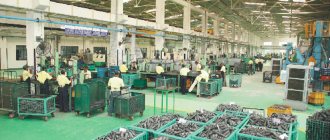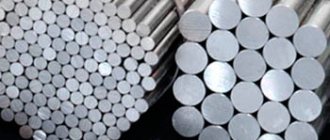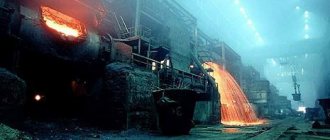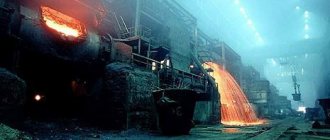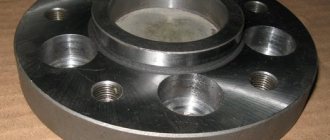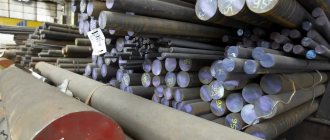Welding springs
And who welded the spring thread - please share
2Belo And it’s hard to ask Google =” > ?
Yes, somehow I didn’t realize it, thanks. I followed the link and just found advice to anneal the welding area first. I didn't search well.
Belo wrote: I cooked autosprings - please share
..and soldered and cooked - the result: the best option is 3 months. Conclusion: melt it down and make a new one (just kidding), or like KAMAZ at Dakar they inserted a crowbar instead of a broken one.. It is possible that I am outdated - nano technology is in the yard..
Fresh wrote: melt down and make a new one
I don’t need it for its intended purpose, but as knives for milling cutters on a walk-behind tractor, so I’m getting ready - to drill (also a hassle) or to cook
Electrodes for spring steel – OK 68. 82
Belo wrote: drill (also a problem) or cook
It seems that 65G steel cannot be welded. I don’t know how to drill, I would burn holes with an electrode, the cutter is a walk-behind mill, no precise balancing is needed.
65G Steel: 70, U8A, 70G, 60S2A, 9HS, 50HFA, 60S2, 55S2 Not applicable for welded structures
Belo wrote: I need it for other purposes
In this case, trying to burn it is an attempt, not torture..
midav wrote: It seems that 65G steel cannot be cooked
Boil, homemade trowels for masons are made from it, but this welding is not enough for a long time.
Drills into glass with drills, but it's tedious.
avaks wrote: 65G Steel: 70, U8A, 70G, 60S2A, 9HS, 50HFA, 60S2, 55S2 Not applicable for welded structures
Absolutely right. But if you really want it, then you can, because a person doesn’t have to cook a structure, but just to sparkle a little bit.
Preheating for welding carbon (in this case, high carbon with a sorbitol structure) the rate of heating and cooling is also important. If in case of failure (breakage) an emergency is excluded, then you can train..
Reference: Structural spring steel 50HGA. Weldability: without restrictions - welding is carried out without heating and without subsequent heat treatment; limited weldability - welding is possible when heated to 100-120 degrees. and subsequent heat treatment, difficult to weld - to obtain high-quality welded joints, additional operations are required: heating to 200-300 degrees. during welding, heat treatment after welding - annealing Taken from here: " >
morgmail wrote: Help: Structural spring-spring steel 50HGA.
morgmail wrote: Taken from here: " >
There in the table “Technological properties of the material 50KhGA.” in the line “Weldability:” it is written – “not applicable for welded structures. “You even need to know how to use a reference book.
Alex___dr wrote: “not applicable for welded structures. “
Who is going to make farms out of this steel? Take my word for it, I know how to use reference books and welders.
morgmail wrote: Who is going to make farms from this steel?
Have you ever seen industrial welded springs?
morgmail wrote: Take my word for it, I know how to use reference books and welders.
Judging by what you cited in your post #13, this (regarding reference books) is hard to believe.
Alex___dr wrote: Have you seen industrial welded springs anywhere?
No, I haven’t seen it, just as I haven’t seen welded products made of cast iron, but this does not mean at all that cast iron cannot be welded. There are enough stories about how welders welded a product that seemed impossible to weld, they just didn’t know about it.
Alex___dr wrote: Judging by what you cited in your post #13, this (regarding reference books) is hard to believe.
Nothing can take away a spring When I was young, I wanted to forge myself a knife from a flat spring. Hard as bastard, absolutely cannot be cut with a blade. There were no Bulgarians then. I burned her at the stake - it didn’t help. I used anthracite, made a small furnace, pumped in air and annealed it, heating the steel until it turned yellow, but it didn’t help. Hard as a file. Threw her to hell. You can't take her bastard with anything, maybe if only an angle grinder cuts her... if you're lucky. And cooking is 100% a lost cause, and most importantly WHY?
Yaroslav_M wrote: And cooking is 100% a lost cause, and most importantly WHY?
[QUOTE=White]I don’t need it for its intended purpose, but as knives for milling cutters on a walk-behind tractor, so I’m getting ready - drilling (also a hassle) or welding. We’re not talking about welding the spring itself, although the spring can be welded, but for how long.
A regular steel drill won't take it. If only you try carbide or tubular with diamond coating.
Yaroslav_M wrote: An ordinary steel drill will not take it. If only you try carbide or tubular with diamond coating.
Like this (I don’t know the diameter you need)” >
I used a drill like this, though Stayer. Tried to drill a hole in the window glass. Drilled in a puddle of kerosene. A lot of work for the drill and very poor results, the edge of the blade quickly became dull. Then I got hold of a tubular diamond drill. Everything was drilled easily, the difference is like heaven and earth. And the hardness of glass is only about 60 HRC. Spring steel has no less hardness, if not more.
In my practice, I welded springs a couple of times. I understood one thing: with a weak current, the spring cracks. Therefore, I cooked the 4th at maximum, with a good leg, so that the heating would be good. Once I welded 6 plates onto the back of an excavator bucket. I scalded the plates completely around the perimeter. I met this excavator about a year later at one site. The springs are well fitted, but in place. The second time they called to the track, the spring holding the rear axle broke on the truck driver. Fortunately, it burst not far from the stepladder. I boiled 300-350 mm on both sides to the bottom sheet. He didn’t give me a guarantee, but he asked me to call him back. The result is about 2000 km, I changed it at home.
Yaroslav_M wrote: And the hardness of glass is only about 60 HRC. Spring steel has no less hardness, if not more.
There is one small nuance. Diamond is not very suitable for steel.
Yaroslav_M wrote: I used such a drill, though Stayer.
I tried to drill with Enkor, Makita and Bosch, Enkor at a price of 30 rubles - 1.5 holes, Makita 3 holes / 90 rubles, Bosch - 5 holes / 150 rubles - and it is still functional, but the rest of the respondents died.
Welding spring steel
taking orders and consultation
Viber (Whatsapp) +375296220572
Receiving orders for repairs and issuing repairs
Before visiting us, call the numbers listed above.
Accepting orders and receiving them from repairs on an urgent basis or for out-of-towners is possible at another convenient time by prior mutual agreement
Our workshop offers you a repair welding service.
leaf springs and semi-springs of trucks.
During the provision of this service, we have already restored hundreds of spring leaves. We weld the spring breaks along the center bolt, along the stepladder, weld the broken fasteners under the silent blocks and the spring fasteners. Welding takes place using a certain technology, which allows you to completely restore the functionality of the spring leaf. You bring in the removed sheets that require repairs and usually receive them back the next day. Spring sheets welded for our Customers successfully work on buses, trailers and semi-trailers, trucks, including heavy four-axle dump trucks and concrete mixers, and on trawls for transporting heavy construction equipment. Customers who have brought us spring leaves for restoration at least once become our regular customers when they understand that the spring leaves we have restored REALLY WORK no worse than new ones. We have had cases when clients brought broken new spring sheets with labels, which worked for 1-2 days, and our sheets still work for them to this day..
Before accepting spring leaves for repair, we inspect them for metal fatigue. If a spring leaf has a network of microcracks to the right and left of the fracture site in the area of 40-50 cm, then such a leaf cannot be repaired. In addition, if a fragment of a spring leaf is lost, then such a leaf cannot be restored (it is impossible to implant a fragment from another spring into a leaf; for this we must have a whole warehouse of fragments of springs of different sections, radii and manufacturers, which is unrealistic).
Restoring springs in our workshop allows our clients to significantly reduce equipment downtime (after all, sometimes new sheets can only be purchased on order for 14-30 days), as well as significantly reduce the cost of repairing and restoring springs (the cost of our work is up to 50% of the cost of new ones sheets). Of course, if the cost of a new spring leaf is comparable to the cost of our work and finding them is not a problem (for example, on MAZ multi-leaf springs), then there is no point in sending them for repair. Well, if spring leaves are expensive, or they are very rare, and the equipment is idle, then contact us and we will help you.
Unfortunately, we do not make eternal springs or springs capable of operating with an overload of 1.5 - 2 times. When installing a new, used or restored spring from us, the Customer must understand that a broken spring is a consequence of something (systematic overload, faulty suspension - shock absorbers, stabilizers, spring fasteners, etc., driving style). And if the cause of the breakdown is not eliminated, any spring leaves will break - new, used, and restored.
We have tested this technology on our own trucks and semi-trailers. Spring sheets restored using a special technology - welding and subsequent heat treatment - are practically no different in their performance characteristics from new or used sheets.
As an example, let's take the MAZ 4370 spring suspension
On average, this part lasts 1-2 years on a car. Then the center bolt breaks. The thickness of the suspension at the point of failure is 45mm. The cost of a new sheet is approximately 170 USD; there are no used sheets on the secondary market. The spring sheets we restored were installed on our MAZ 4370 and MAZ 4371 cars.
The service life of the restored suspension sheets averaged more than 1 year. The cost of restoring this spring element is estimated at approximately 90 USD) As you can see, the cost of restoration is approximately two times cheaper than purchasing a new spring spring with a service life comparable to the new one.
What is spring steel?
Spring steel is a medium or high carbon steel with a low volume of alloying elements (up to 2.5%), but a significant yield strength. This determines the property of products made of such metal to acquire their original shape, despite significant bending, fracture, torsion and dynamic loading. This feature is used in the production of spring products, metal swords, piano strings and spring clamps.
Hardening of spring steel followed by tempering at 400-500 °C to a value of 45 HRC are mandatory production stages. Springs made from improperly hardened material become brittle and crumble easily. The heat treatment of spring steels in many industries has been thoroughly mastered by thermists and is carried out in accordance with the regimes regulated in the standards.
The main requirements that are set for spring steels and alloys are to ensure increased indicators of flexibility, ductility, endurance, resistance to brittle fracture, and resistance to stress weakening. This is achieved to a greater extent due to the addition of alloying elements. Silicon is a fundamental component of steel alloys of this type. Melting in ferrite, it contributes to the formation of persistent heterogeneity of carbon atoms that delay dislocation. In parallel with the increase in the hardness of the alloy, silicon significantly reduces its ductility and causes decarburization, which greatly limits the use of inexpensive, pure silicon alloys.
Welding of spring and spring steel
Are you interested in welding spring and spring steel? The supplier Evek GmbH offers to buy spring and spring steel in any quantity at an affordable price in a wide range. We will ensure delivery of products to any point on the continent. The price is optimal.
Features of welding spring steels
The steels in question contain at least 0.5...0.75% carbon, and are often alloyed with other elements - chromium, vanadium, silicon. The most commonly used heat treatment mode for such steels (quenching from 850...880o C in oil and subsequent tempering at 400...640o C) gives the steel the necessary strength and ductility, but makes welding difficult. Therefore, welding of spring steels can be successful only if the parts being welded are preheated (annealed). After welding, it is necessary to perform final heat treatment of the joint. But it is recommended, if possible, to avoid welds in spring steel structures.
50HGA
The exception is spring steel grade 50HGA, which is welded without restrictions, while welding is carried out without heating and without subsequent heat treatment. At the same time, in this case, in order to obtain a durable connection, preheating is performed to 200...300°C, and then annealing is performed. Evek GmbH offers to buy spring and spring steel at an affordable price in a wide range. We will ensure delivery of products to any point on the continent. The price is optimal.
Welding modes of spring steels
If absolutely necessary, use electric welding at the maximum current - not lower than 200 A, forming a weld leg of the largest possible size: this ensures satisfactory heating of the metal. In order to increase the efficiency of the welding process and reduce the consumption of welding electrodes, it is recommended to use a pulse-arc microwelding machine (for example, type Orion PA230). Good results are obtained by welding using electrodes made of austenitic stainless steel: in this case, the quality of the weld increases due to the increased solubility of hydrogen in the melt and the resulting increased ductility of the metal.
Buy. Supplier, price
Are you interested in welding spring and spring steel? The supplier Evek GmbH offers to buy spring and spring steel in any quantity at the manufacturer's price. We will ensure delivery of products to any point on the continent. The price is optimal. We invite you to partner cooperation/
Properties and applications of spring steel
The presence of silicon in different spring steels is 0.17-2.60% depending on the class. In addition, chromium and manganese are considered useful alloying additives in cumulative alloying, since they increase resistance to low plastic deformations, while simultaneously increasing many of the technological properties of the alloy. The addition of vanadium, molybdenum and tungsten inclusions ensures the formation of a stable thin homogeneous structure and a carbide fraction that blocks dislocation. To improve the technical and operational properties, microdoses of boron are introduced into the steel composition.
Spring steel grades 70SZA and 60S2XA are distinguished by their maximum physical and mechanical properties. Their elasticity parameters reach 1100 MPa, and their hardness is up to 48 HRC on the Rockwell scale. With these indicators, the metal is sensitive to stress concentrators (surface defects). In their absence, the parameters of the metal’s endurance in bending are above 550 MPa, and in torsion – 350 MPa. To reduce this sensitivity, finished products receive external oaklen by blasting with shot. As a result of such hardening, endurance indicators increase by 2 times.
Stainless steel wire is used for the manufacture of compression, tension and torsion springs, which are used without insulation in distillate, water-steam environment, saline, alkaline and alcohol solutions, and sea water. This wire is optimally suited for the production of springs used in the chemical and food industry, for operation in the temperature range of −250 °C…+250 °C.
Structural spring steel 65g is most widely used in the production of elastic parts of various mechanisms (springs, springs and washers) due to its low cost, increased hardness and elasticity. The only drawback limiting its use in instrument making is its low fatigue strength (less than 200,000 cycles). Steel of this grade has an unhardened hardness of 25 HRC, after hardening it increases to 61 HRC.
Alloy spring steel 60s2a is characterized by low cost, high elasticity, wear resistance, and lack of temper brittleness. This metal is not afraid of deformation from physical and mechanical contacts and pressure. It does not require a protective coating and can be used effectively in normal humidity. The maximum temperature for its use is no more than 250 ºС. Used in the production of a variety of rolled metal products.
Spring sheet steel is relevant in the production of marine, food and medical equipment, where the working environment requires increased corrosion resistance. This steel is slightly inferior in strength to stainless steel.
The corrosion resistance of spring stainless steels is associated with increased levels of chromium and molybdenum. In addition, they combine excellent resistance to cracking under load and significant physical and mechanical strength.
Welding spring steel has its challenges. As a rule, the metal is pre-strengthened by a thermal method, and during welding this hardening is destroyed. A solution to the problem can be welding with an appropriate ferrite electrode through preheating and further tempering to prevent cracks in the thermally affected area. When welding with austenitic electrodes based on stainless steel or nickel, the risk of cracking is reduced due to the increased solubility of hydrogen and the good ductility of the melting metal.
An alphanumeric marking system for spring steel has been officially adopted. The main alloying additives have a special letter code. The numerical designation shows the percentage level of a particular element. If the amount of an individual component does not exceed 1.5%, then the number after the letter index is not indicated. The carbon level is displayed at the beginning of the code in hundredths of a percent.
Welding spring steel - Metalworker's Handbook
Many elastic elements play a key role in the operation of various components and mechanisms.
During operation, they are subjected to numerous alternating loads, under the influence of which they are reversibly deformed, returning to their original shape and dimensions after completion of the load.
A characteristic difference between their functioning is that under significant static and impact impacts they receive only elastic deformation, and residual deformation does not occur.
What is spring steel?
Spring steel is a medium or high carbon steel with a low volume of alloying elements (up to 2.5%), but a significant yield strength.
This determines the property of products made of such metal to acquire their original shape, despite significant bending, fracture, torsion and dynamic loading.
This feature is used in the production of spring products, metal swords, piano strings and spring clamps.
Hardening of spring steel followed by tempering at 400-500 °C to a value of 45 HRC are mandatory production stages. Springs made from improperly hardened material become brittle and crumble easily. The heat treatment of spring steels in many industries has been thoroughly mastered by thermists and is carried out in accordance with the regimes regulated in the standards.
The main requirements that are set for spring steels and alloys are to ensure increased indicators of flexibility, ductility, endurance, resistance to brittle fracture, and resistance to stress weakening. This is achieved to a greater extent due to the addition of alloying elements.
Silicon is a fundamental component of steel alloys of this type. Melting in ferrite, it contributes to the formation of persistent heterogeneity of carbon atoms that delay dislocation.
In parallel with the increase in the hardness of the alloy, silicon significantly reduces its ductility and causes decarburization, which greatly limits the use of inexpensive, pure silicon alloys.
Properties and applications of spring steel
The presence of silicon in different spring steels is 0.17-2.60% depending on the class.
In addition, chromium and manganese are considered useful alloying additives in cumulative alloying, since they increase resistance to low plastic deformations, while simultaneously increasing many of the technological properties of the alloy.
The addition of vanadium, molybdenum and tungsten inclusions ensures the formation of a stable thin homogeneous structure and a carbide fraction that blocks dislocation. To improve the technical and operational properties, microdoses of boron are introduced into the steel composition.
Spring steel grades 70SZA and 60S2XA are distinguished by their maximum physical and mechanical properties. Their elasticity parameters reach 1100 MPa, and their hardness is up to 48 HRC on the Rockwell scale.
With these indicators, the metal is sensitive to stress concentrators (surface defects). In their absence, the parameters of the metal’s endurance in bending are above 550 MPa, and in torsion – 350 MPa.
To reduce this sensitivity, finished products receive external oaklen by blasting with shot. As a result of such hardening, endurance indicators increase by 2 times.
Stainless steel wire is used for the manufacture of compression, tension and torsion springs, which are used without insulation in distillate, water-steam environment, saline, alkaline and alcohol solutions, and sea water. This wire is optimally suited for the production of springs used in the chemical and food industry, for operation in the temperature range of −250 °C…+250 °C.
Structural spring steel 65g is most widely used in the production of elastic parts of various mechanisms (springs, springs and washers) due to its low cost, increased hardness and elasticity.
The only drawback limiting its use in instrument making is its low fatigue strength (less than 200,000 cycles).
Steel of this grade has an unhardened hardness of 25 HRC, after hardening it increases to 61 HRC.
Alloy spring steel 60s2a is characterized by low cost, high elasticity, wear resistance, and lack of temper brittleness. This metal is not afraid of deformation from physical and mechanical contacts and pressure.
It does not require a protective coating and can be used effectively in normal humidity. The maximum temperature for its use is no more than 250 ºС. Used in the production of a variety of rolled metal products.
Spring sheet steel is relevant in the production of marine, food and medical equipment, where the working environment requires increased corrosion resistance. This steel is slightly inferior in strength to stainless steel.
The corrosion resistance of spring stainless steels is associated with increased levels of chromium and molybdenum. In addition, they combine excellent resistance to cracking under load and significant physical and mechanical strength.
Welding spring steel has its challenges. As a rule, the metal is pre-strengthened by a thermal method, and during welding this hardening is destroyed.
A solution to the problem can be welding with an appropriate ferrite electrode through preheating and further tempering to prevent cracks in the thermally affected area.
When welding with austenitic electrodes based on stainless steel or nickel, the risk of cracking is reduced due to the increased solubility of hydrogen and the good ductility of the melting metal.
| Every builder should know the classification and types of reinforcement. The classes do not depend in any way on the material of construction, although it is indicated in the designation of the products. The information is important because the possibility of using the parts...... |
| Crimp couplings for connecting reinforcement allow you to evenly connect 2 pins by crimping them together without preliminary preparation of the ends. Good docking and a continuous system of joints are the key to a reliable connection in rigid...... |
| Basalt-plastic and fiberglass reinforcement, which appeared on the market relatively recently, meet all safety requirements and in many respects significantly surpass traditional metal structures. The production of fittings is carried out using the latest...... |
| The diameter of the steel bars affects the final weight of the periodic profile reinforcement. The weight of a thick brand of products reaches 50 kg. At the same time, a decrease in the total mass of the building affects the construction of the foundation for...... |
Welding medium and high carbon steels
Medium carbon steel structures can be welded well if the welding rules and the following additional guidelines are strictly observed.
In butt, corner and T-joints, when assembling the elements being connected, the gaps provided by GOST should be maintained between the edges so that welding transverse shrinkage occurs more freely and does not cause crystallization cracks.
In addition, starting from a steel thickness of 5 mm or more, edges are cut in butt joints, and welding is carried out in several layers. The welding current is reduced.
Welding high carbon steel
Welding high-carbon steels of grades VSt6, 45, 50 and 60 and cast carbon steels with a carbon content of up to 0.7% is even more difficult. These steels are mainly used in castings and tool making.
Their welding is possible only with preliminary and concomitant heating to a temperature of 350-400 ° C and subsequent heat treatment in heating furnaces.
When welding, the rules for medium carbon steel must be followed; we will discuss this process below.
Welding technologies for high carbon steels
Good results are achieved when welding narrow beads and small areas with cooling of each layer. After welding is completed, heat treatment is required.
Welding medium carbon steel
Welding medium-carbon steel grades VSt5, 30, 35 and 40, containing carbon 0.28-0.37% and 0.27-0.45%, is more difficult, since the weldability of steel deteriorates with increasing carbon content.
Medium carbon steel of the VSt5ps and VSt5sp grades used for reinforced concrete reinforcement is welded using the bath method and conventional extended seams when connecting to the linings (Fig. 16.1).
For welding, the ends of the connected rods must be prepared: for welding in the lower position, cut off with a cutter or saw, and for vertical welding, cut. In addition, they must be cleaned at the joints to a length that exceeds the weld or joint by 10-15 mm.
Welding is performed with electrodes E42A, E46A and E50A for extended bead seams. At air temperatures down to minus 30 ° C, it is necessary to increase the force
Rice. 16.1. Welding joints of reinforced concrete reinforcement: a - bathroom; 1 - horizontal; 2 - vertical; b - suture
welding current by 1% when the temperature decreases from 0°C for every 3°C. In addition, you should use preheating of the joined rods to 200-250 °C for a length of 90-150 mm from the joint and reduce the cooling rate after welding by wrapping the joints with asbestos, and in the case of bath welding, do not remove the forming elements until the joint is cooled to 100 °C and below.
Welding manganese steels
Manganese structural steel for special purposes has a unique combination of strength and toughness, which is used for the manufacture of armor, tracks, tanks, leaf springs, springs. The products are characterized by high wear resistance to abrasion and shock loads. They are produced by casting, but during operation they often require welding of manganese steels. This can be either the creation of a new design or the fusing of a worn part.
The weldability indicator is the carbon equivalent, the formula of which includes: C, Mn, Si, Cr, Ni, Cu - arrangement according to influence. The main alloying elements are carbon and manganese: the higher their content, the more complicated the process. An alloy with C up to 0.25% is considered well weldable, but as the indicators increase, this ability decreases.
Features of the chemical composition of manganese steels
Important! During operation, it is necessary to ensure rapid cooling of the weld, since prolonged heating causes the release of carbides and a decrease in strength.
The presence of C 0.6-1.2%, Mn 1-14% can also be alloyed with other elements in amounts up to 1%. When melted, the bulk of the components combine with oxygen, releasing slag, carbon forms CO gas, i.e. burns out. The slag, in turn, interferes with the process: it closes the electric arc, partially enters the melt and reduces the strength of the connection. The oxidation process reduces the content of materials in the melt, which completely changes the original chemical composition, and therefore the properties.
Welding manganese austenitic steels is also complicated by structural changes in the heat-affected zone. Heating to recrystallization temperatures leads to the precipitation of carbides, grain growth, i.e., a local change in the properties of the metal due to transformation of the structure - a decrease in strength and toughness, and an increase in fragility.
Types and technologies of the welding process
The technology for welding manganese steels, regardless of the method used, must take into account all negative factors and ensure:
- Protection against oxidation. This function is partially performed by slag, what happens after its formation and why some of the elements are spent. To completely prevent the oxidation process, a protective atmosphere must be used. As a rule, this is the use of vacuum - a technology that is expensive and difficult to implement. Argon-arc welding is much more practical. It will be appropriate both in industrial conditions and private use.
- Partial or complete restoration of the chemical composition. The content of elements in the weld changes radically; in order to partially or completely replenish it, electrodes coated with similar elements are used. There are manganese and aluminum varieties with a dosed content of elements.
- Form of surfacing. When alloys burn out, they form a large amount of carbon monoxide, which not only hinders visibility. Being retained in the melt, they reduce the strength of the structure. To ensure their exit, surfacing with electrodes is carried out with widened stitches.
- Fast cooling. Prolonged heating and slow cooling of Mn steels lead to the precipitation of carbides, which reduce the strength and make the weld brittle. The optimal ratio in terms of heating and cooling rates is the electric arc method.
Welding 65G steel is difficult due to the C content. For these grades, a number of conditions are applied that reduce the consequences of intervention in the structure. Essentially, the process is the surfacing of an intermediate layer between surfaces. For this purpose, electrodes of a certain composition are used, they are selected depending on the degree of alloying.
Using electrodes containing Mn, surfacing is carried out on ordinary structural steel, thereby giving it the wear resistance inherent in Mn steels. The procedure is carried out in 4 layers, in each of which the manganese content increases.
Welding of 16GS steel is performed using the electroslag method in a protective gas atmosphere under submerged arc. It is not prone to temper brittleness and is characterized by high resistance to overheating in the heat-affected zone. Electrodes E42, E50A are recommended for surfacing.
The methods and side effects of welding 09G2S steel are similar to those described above. For the semi- and automatic method, electrode wire SV08GA, SV-YUGA, SV10G2 + flux AN-348A, OSTS-45 are used.
Welding steel 30KhGSA. Alloying with chromium and silicon in the heat-affected structure provides not only a ferrite-pearlite composition (a certain amount of bainite and martensite is formed), but also long-term cooling, which contributes to the precipitation of carbides along the grain boundaries and the appearance of increased fragility. Electrodes E55A, E60, E55 are used here.
Welding spring steel, as well as welding spring steel, is practically impossible. Grade 50HGA is not intended for welded structures. It obtains the effect of a spring during plastic deformation in a cold state, and during weldability in the heat-affected zone, the result is partial tempering and loss of strength. A compromise is the use of OK 68/82 electrodes, which are optimal for surfacing transition layers.
Welding 09G2S steel, the technology of which provides for joining in any configuration, including welding of strip steel, differs from high-alloy steel - in this case, the principle of fusion is characteristically similar to deposition. Docking can be carried out in different ways: continuous reflow with or without heating. Gaps when welding metal are allowed depending on the cross-section and type of melting - from 0.5 to 8 mm.
Weldability of spring steels
Many elastic elements play a key role in the operation of various components and mechanisms.
During operation, they are subjected to numerous alternating loads, under the influence of which they are reversibly deformed, returning to their original shape and dimensions after completion of the load.
A characteristic difference between their functioning is that under significant static and impact impacts they receive only elastic deformation, and residual deformation does not occur.
High-strength steels and their welding features
Steels with a tensile strength greater than 1500 MPa are called high-strength. This limit is achieved by selecting the chemical composition and the most suitable heat treatment. This level of strength can be formed in medium-carbon alloy steels (40ХН2МА, 30ХГСН2А) by using hardening with low tempering (at 200...250оС).
Alloying such steels with W, Mo, V complicates softening processes, which reduces the threshold of cold brittleness and increases resistance to brittle fracture.
How to weld metal if you have high-strength steel in front of you? Welding of high-strength steels is characterized by the use of some additional technological techniques (welding in cascades, slides, sections, preheating, the use of a soft layer and others). Hardened steels (structure)
Isothermal hardening of medium-carbon alloy steels gives them slightly lower strength, but greater toughness and ductility. Therefore, they are more reliable in operation than low-tempered and hardened ones.
Low-tempered and hardened medium-carbon steels with a high level of strength have an increased susceptibility to stress concentrators and a tendency to brittle fracture.
Because of this, they are recommended to be used for work involving smooth loading.
High-strength steels include so-called spring steels. They contain 0.5...0.75% C and are additionally alloyed with other elements.
Heat treatment of alloy spring steels (quenching 850...880°C, tempering 380...550°C) ensures high strength and fluidity. Isothermal hardening can be used.
Welding of spring steel is carried out with mandatory preliminary heat treatment, with heating during welding and further heat treatment.
Maraging steels (04Х11Н9М2Д2ТУ, 03Н18К9М5Т) also belong to high-strength steels. They are superior to medium-carbon alloy steels in structural strength and manufacturability. Such steels are characterized by high resistance to brittle fracture, a low threshold of cold brittleness and low sensitivity to cuts with a strength of about 2000 MPa.
Maraging steels are carbon-free alloys of iron and nickel and are additionally alloyed with molybdenum, cobalt, aluminum, chromium, titanium and other elements.
These steels have high structural strength in the temperature range from cryogenic to 500°C and are used in the manufacture of artillery and small arms barrels, rocket engine housings, gears, spindles, and so on.

